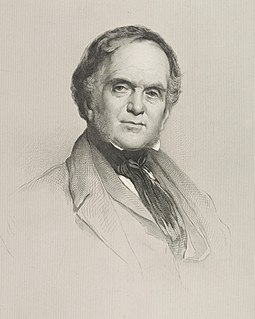This page is based on this
Wikipedia article Text is available under the
CC BY-SA 4.0 license; additional terms may apply.
Images, videos and audio are available under their respective licenses.

The Scottish National Gallery is the national art gallery of Scotland. It is located on The Mound in central Edinburgh, close to Princes Street. The building was designed in a neoclassical style by William Henry Playfair, and first opened to the public in 1859.
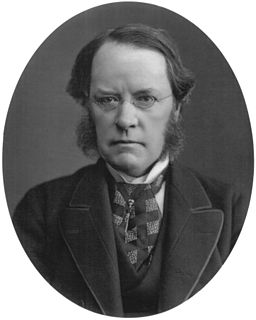
Lyon Playfair, 1st Baron Playfair was a British scientist and Liberal politician.

John Playfair FRSE, FRS was a Church of Scotland minister, remembered as a scientist and mathematician, and a professor of natural philosophy at the University of Edinburgh. He is best known for his book Illustrations of the Huttonian Theory of the Earth (1802), which summarised the work of James Hutton. It was through this book that Hutton's principle of uniformitarianism, later taken up by Charles Lyell, first reached a wide audience. Playfair's textbook Elements of Geometry made a brief expression of Euclid's parallel postulate known now as Playfair's axiom.

The Royal Scottish Academy building, the home of the Royal Scottish Academy, is situated on The Mound in the centre of Edinburgh, was built by William Henry Playfair in 1822-6 and extended in 1831-6 for the Board of Manufactures and Fisheries. Along with the adjacent National Gallery of Scotland, their neo-classical design helped transform Edinburgh into a modern-day Athens of the North.

The Royal Scottish Academy (RSA) is the country’s national academy of art. It promotes contemporary Scottish art.
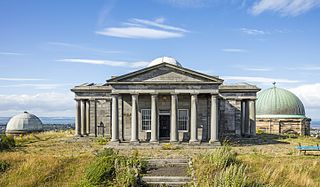
The City Observatory is an astronomical observatory on Calton Hill in Edinburgh, Scotland. It is also known as the Calton Hill Observatory.

Old College is a building of the University of Edinburgh, Scotland. It is located on South Bridge, and presently houses parts of the University's administration, the University of Edinburgh School of Law, and the Talbot Rice Gallery. Originally called the "New College", it was designed by Robert Adam to replace a number of older buildings.

The Cathedral of St Andrew is a ruined Roman Catholic cathedral in St Andrews, Fife, Scotland. It was built in 1158 and became the centre of the Medieval Catholic Church in Scotland as the seat of the Archdiocese of St Andrews and the Bishops and Archbishops of St Andrews. It fell into disuse and ruin after Catholic mass was outlawed during the 16th-century Scottish Reformation. It is currently a monument in the custody of Historic Environment Scotland. The ruins indicate that the building was approximately 119 m (390 ft) long, and is the largest church to have been built in Scotland.

James Playfair was a Scottish architect who worked largely in the neoclassical tradition.
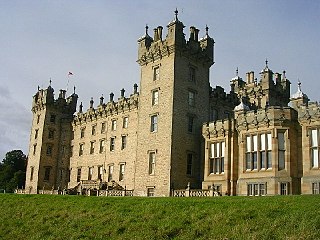
Floors Castle, in Roxburghshire, south-east Scotland, is the seat of the Duke of Roxburghe. Despite its name it is a country house rather than a fortress. It was built in the 1720s by the architect William Adam for Duke John, possibly incorporating an earlier tower house. In the 19th century it was embellished with turrets and battlements by William Playfair for Duke James. Floors has the common 18th-century layout of a main block with two symmetrical service wings. Floors Castle lies on the River Tweed and overlooks the Cheviot Hills to the south.

The Dugald Stewart Monument is a memorial to the Scottish philosopher Dugald Stewart (1753–1828). It is situated on Calton Hill overlooking the city of Edinburgh and was designed by Scottish architect William Henry Playfair. It was completed in September 1831.

Prof William Wallace LLD was a Scottish mathematician and astronomer who invented the eidograph.
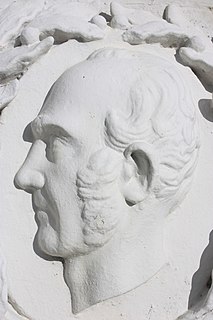
Sir Hugh Lyon Playfair LL.D Kt was a Scottish politician, army officer and photographic pioneer. He was Provost of St Andrews from 1842 until his death in 1861.

Playfair is an impact crater in the Mare Australe quadrangle of Mars, located at 78.1°S latitude and 126.2°W longitude. It measures 64.2 kilometers in diameter and was named after Scottish scientist and mathematician John Playfair. The naming was approved in 1973, by the IAU's Working Group for Planetary System Nomenclature.
Playfair is a surname. Notable people with the surname include:
Events from the year 1738 in Scotland.
Events from the year 1748 in Scotland.

Carlton Terrace is a residential street in Edinburgh, Scotland. It is located on the east side of Calton Hill, at the eastern extremity of the New Town, part of the UNESCO World Heritage Site inscribed in 1995.


